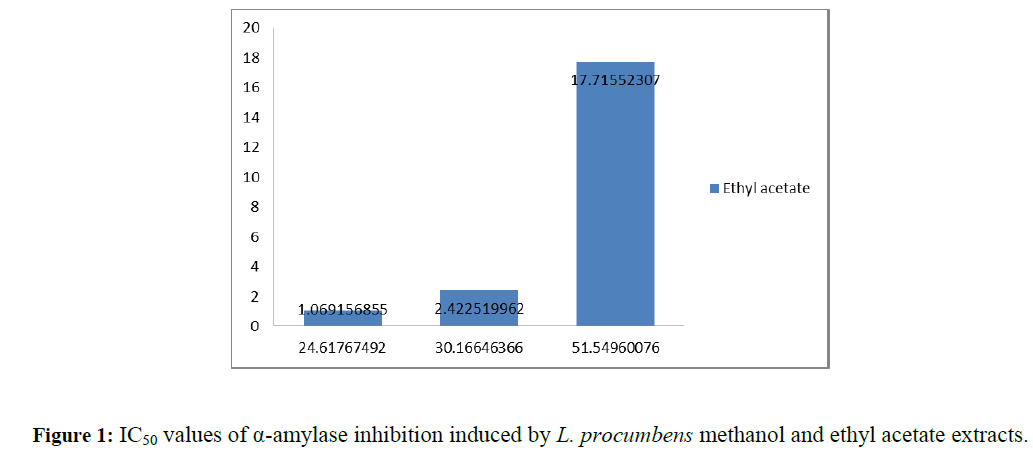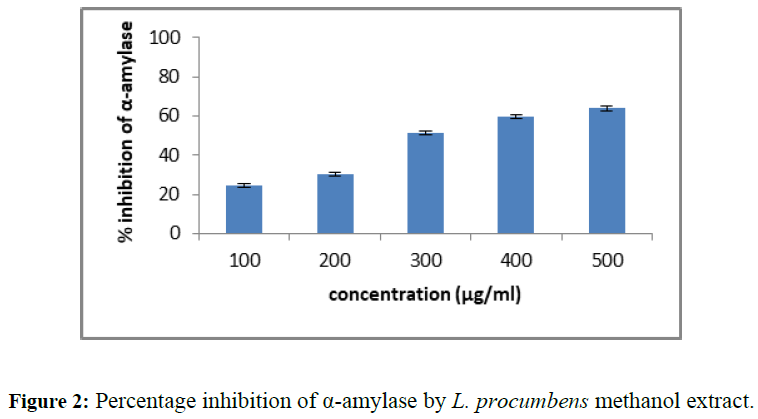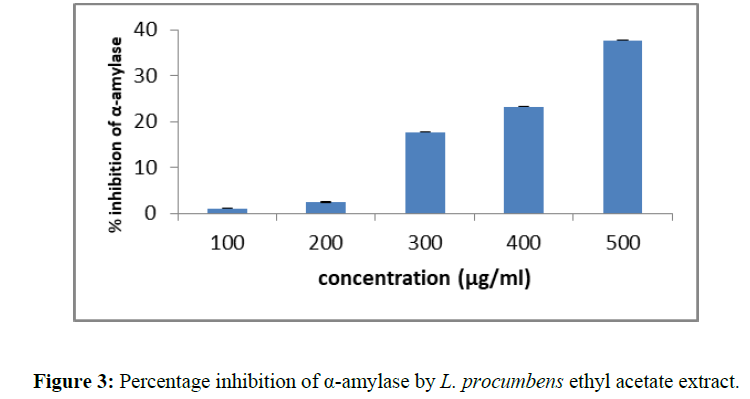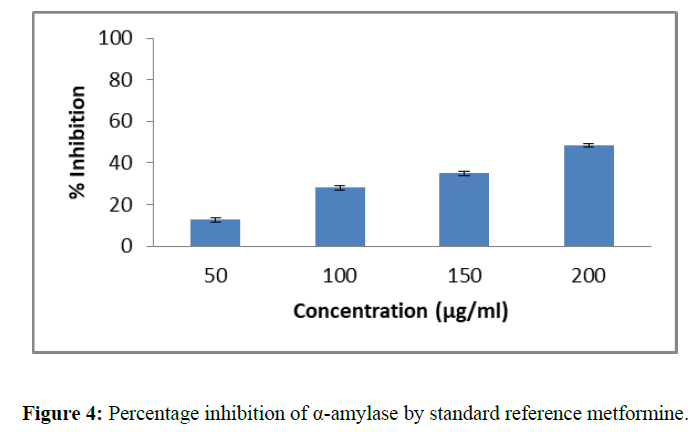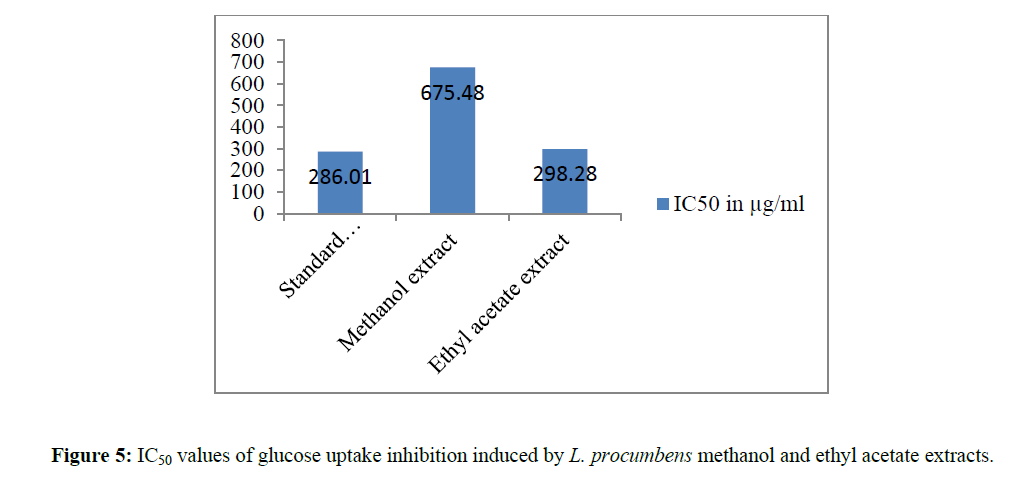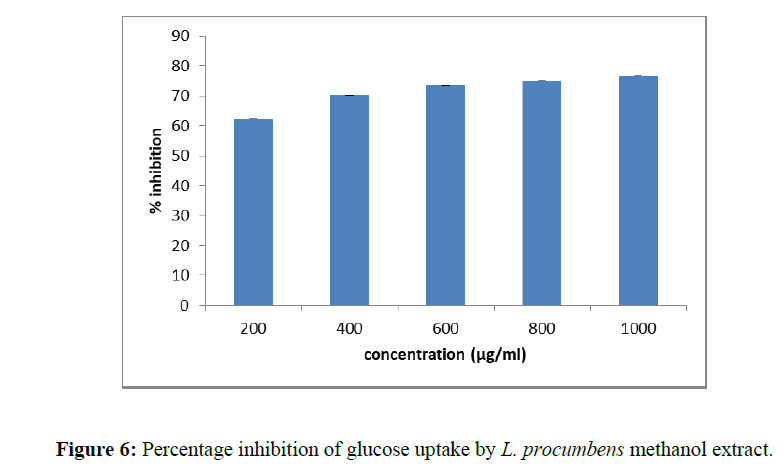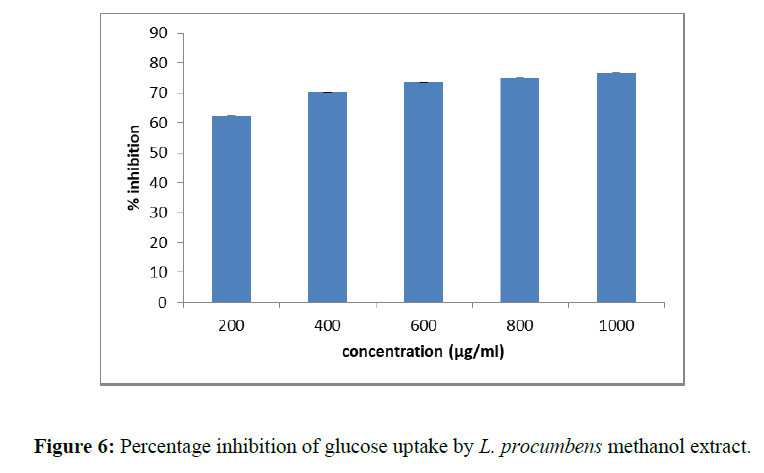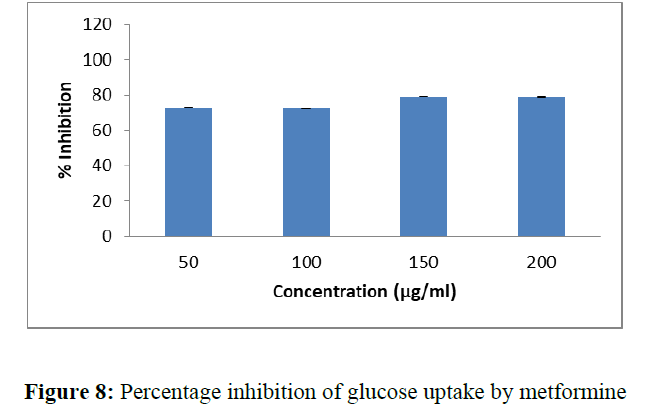Research Article - Der Pharma Chemica ( 2022) Volume 14, Issue 3
In-Vitro Antidiabetic Activity of Launaea procumbens Extracts
Indirabai M.B1*, Pujari N1, Madagi S.B2 and Hoskeri H32Professor, Department of Bioinformatics, Akkamahadevi Womens University, Vijayapura, Karnataka, India
3Assistant Professor, 2Department of Bioinformatics, Akkamahadevi Womens University, Vijayapura, Karnataka, India
Indirabai M.B, Department of Bioinformatics, Akkamahadevi Womens University, Vijayapura, Karnataka, India, Email: indirab.26@gmail.com
Received: 05-Feb-2022, Manuscript No. dpc-22-53614; Accepted Date: Mar 08, 2022 ; Editor assigned: 08-Feb-2022, Pre QC No. dpc-22-53614; Reviewed: 24-Feb-2022, QC No. dpc-22-53614; Revised: 02-Mar-2022, Manuscript No. dpc-22-53614; Published: 10-Mar-2022, DOI: 10.4172/0975-413X.14.3.16-21
Abstract
Medicinal plants have gained broad range of attention in recent years for their vital pharmacological properties. Launaea procumbens is one among the potential medicinal plants traditionally used for the treatment of several diseases. With increase in the growth rate of diabetic patients and also with pronounced side effects of already available treatments, search for medicines from natural sources is always a matter of interest for researchers. Therefore in current study, methanol and ethyl acetate extracts of L. procumbens were studied for anti-diabetic potential through in-vitro approach. In this study, in-vitro amylase inhibition assay and glucose uptake assay were carried out. Results are reported in a dose dependent inhibition of α-amylase in methanol extract. Whereas yeast cells showed significant increase in inhibition of glucose uptake in methanol extracts of L. procumbens. Hence the anti-diabetic activity was prominently seen in methanol extract of L. procumbens, therefore the study can be of great interest in further exploring of anti-diabetic activity of L. procumbens by in-vivo and in-silicon approaches.
Keywords
L. procumbens; ɑ-Amylase; ɑ-Glycosidase; Anti diabetic; Medicinal plants.
Introduction
Diabetes is one of the wide spread degenerative diseases that has taken over most parts of the world. An epidemiological study reports that an estimate of about 462 million individuals are diabetic worldwide, which accounts for about 6.28% of the global population [1] The condition is known by inability of cells to utilize glucose or insensitive to insulin. Therefore a fasting blood sugar level more than 125 units or more than 200 units in random blood sugar level is diagnosed as diabetes. Complications also include alteration in lipid peroxidation, glycation and protein inhibition [2]. However, over the years several treatments are found to be effective in management of diabetes which mainly includes antioxidant chemicals and hypoglycemic drugs. Some of the prominent ones include insulin, sulfonylureas, metformin, Na+-glucose exchanger inhibitors, insulin analogs and α-glycosidase inhibitors. In spite of several therapies, these treatments are reported to pose potential side effects [3, 4], thus considering natural medicines is a suitable alternative. Medicinal plants cover a large part of traditional medicines for their wide range of pharmacological values in relation with distribution, low cost, safety and efficacy [5]. Launaea procumbens is one among the widely studied medicinal plant seen to be grown in vacant lods and in agricultural lands. It is also known to be cultivated in some parts of India as food crop. L. procumbens is traditionally used in the treatment of rheumatism and kidney dysfunction [6, 7]
However, anti-diabetic potential of L. procumbens is not yet explored. Therefore current study was focused to investigate preliminary anti-diabetic property methanol and ethyl acetate extracts of L. procumbens.
Materials and Methods
Plant Collection
Leaves of L. procumbens were collected from the local area of Vijayapura district and surroundings of Karnataka State Akkamahadevi Women’s University regions in the month of October. Leaves were thoroughly washed in the running tap water and shade dried at room temperature (25 °C) for 30 days. The dried plant material was powdered mechanically. Powdered material was further subjected to Soxhlet extraction using ethyl acetate and methanol as solvent system. Ethyl acetate and methanol extracts were vacuum evaporated using rotary evaporator. Dried ethyl acetate and methanol extracts were used for analysis.
Alpha-Amylase Assay
In-vitro α-amylase activity can be measured by hydrolysis of starch in the presence of α-amylase enzyme. This process can be quantified using DNS reagent which gives orange-red colour in presence of monosaccharide. The reduced intensity of orange colour indicates that enzyme-induces hydrolysis of starch into monosaccharide. The intensity of starch colour in the test sample is directly proportional to the α-amylase inhibitory activity. Equal volume of plant extract, 0.5% (w/v) starch and α-amylase was homogeneously mixed into a test tube. The mixture was incubated at 20°C for 3 min. After incubation Dinitrosalicylic acid (DNS) was added to stop the enzymatic reaction. Then the solution was removed from heating process and cooled at room temperature for 3 min. The α-amylase activity was determined at 540 nm using spectrophotometer (Labman UV Visible Spectrophotometer) to measure product absorbance which reduces DNS. The produced absorbance was compared with blank. The percent of enzyme inhibition was calculated using the following formula:
% of α-amylase inhibition= [(Ac-As)/Ac] ×100
where,
Ac and as are the absorbance of control and sample, respectively. Percent inhibition was calculated using the formula [8, 9].
Glucose Uptake Assay
Insulin stimulates glucose uptake into muscle through increased glucose transporter activity. To study glucose uptake activity, Saccharomyces cerevisiae cells were suspended in distilled water was subjected to centrifugation at 3000 rpm for 5 min and supernatant was discarded. From the pellet, 10% (v/v) of the suspension was prepared using distilled water. To five different concentration (200, 400, 600, 800 and 1000 μg/ml) of plant extracts 5 mM glucose solution was added and incubated for 10 min at 37 °C. Reaction was initiated by adding 100μl yeast suspension followed by vortexing and further incubation at 37°C for 60 min. After 60 min the tubes were centrifuged at 2500 rpm for 5min. Amount of glucose present in supernatant was further estimated via DNS method [10].
Result
Alpha-Amylase Assay
Alpha-amylase assay was carried out for methanol and ethyl acetate extracts of L. procumbens and metformine was used as standard reference. IC50 values revealed percent inhibition of α- amylase by methanol and ethanol extracts of L. procumbens (Figure 1). The assay was carried out in five different concentrations (100, 200, 300, 400 and 500μg/ml). IC50 values of each of the samples are given in (Table 1), where methanol extract has showed with least IC50 value of 337.59μg/ml indicating potential inhibition of α-amylase. Methanol extract showed measurable inhibition of α-amylase at 500 μg/ml concentrations with 63.8%, while at 100 μg/ml showed 24.6% inhibition (Figure 2). Ethyl acetate extract of L. procumbens showed comparatively less percentage inhibition at 500 μg/ml concentrations with 37.7 %, while lowest inhibition was found at 100 μg/ml concentrations with only 1% inhibition (Figure 3). Metformin showed least inhibition activity of α amylase at 100 μg/ml and 500 μg/ml concentrations, while 48.4% inhibition was reported at 400 μg/ml concentrations (Figure 4).
| Concentrations | % Inhibition | % Inhibition | % Inhibition |
|---|---|---|---|
| µg/ml | Methanol | Ethyl acetate | metformine |
| 100 | 24.6177 | 1.06916 | 12.5276 |
| 200 | 30.1665 | 2.42252 | 28.0913 |
| 300 | 51.5496 | 17.7155 | 35.0386 |
| 400 | 59.9405 | 23.2643 | 48.482 |
| 500 | 63.8652 | 37.7182 | 52.5276 |
Glucose Uptake Assay
Glucose uptake regulation was investigated on methanol and ethyl acetate extracts of L. procumbens along with standard drug metformin. Analysis of five different concentrations of the extracts were studied their effects on glucose uptake system in yeast cell. Methanol extract showed increase in inhibition of glucose uptake with increase in concentration of extract (Figure 4). However showing highest inhibition of 76% at 500 μg/ml concentration. Ethyl acetate extract showed lowest inhibition of 24.4% at 500 μg/ml concentration, indicating decrease in inhibition rate with increase in ethyl acetate extract (Figure 5). Standard drug metformin showed best inhibition at 300 μg/ml and 400 μg/ml concentration showing 79% inhibition (Table 2). Ethyl acetate reported lowest IC50 value of 298.28μg/ml which was much closer to metformine, which showed IC50 value of 286.01μg/ml (Figure 6-8).
| Concentrations µg/ml |
% Inhibition Methanol |
% Inhibition Ethyl acetate |
% Inhibition metformine |
|---|---|---|---|
| 100 | 62.22898743 | 57.18596956 | 72.85506287 |
| 200 | 70.17868961 | 41.28127068 | 72.51356717 |
| 300 | 73.56187955 | 36.47385837 | 79.20052945 |
| 400 | 74.88021178 | 36.05559232 | 79.06287227 |
| 500 | 76.60357379 | 24.42356056 | 72.85506287 |
Discussion
Medicinal plants and herbal medicines are age old treatments used in traditional medicines for management of diabetes [11]. L. procumbens is one among the well-studied medicinal plants known for various therapeutic attributes such as phytochemicals like vitexin, orientin, rutin, hyperoside, catechin and myricetin (flavonoids) present in methanol extracts of L. procumbens were reported to show antioxidant activity [12]. Similarly, L. procumbens is also reported to show protective effects against reneal disorders [13], lung disorders [14] hepatoprotective activity in rat models [15] and also antimicrobial activity against several strains of bacteria [16] In present study, methanol and ethyl acetate extracts of L. procumbens are investigated for possible significance in controlling of glucose metabolism through inhibition of α-amylase and glucose uptake assays. Positive correlation between pancreatic α-amylase and postprandial glucose level is the key factor for targeting α-amylase inhibition, which helps in management of diabetes [17]. Various plant extracts are known to be potential in inhibiting α-amylase enzyme, such as methanol extracts of Psidium guajava leaves are capable of inhibiting upto 96.3% [18]. Also methanol extracts of Tamarindus indica leave extract is reported to inhibit 90% of α-amylase activity [19]. In current study methanol extract of L. procumbens showed dose dependent increase in inhibition with 63.8% as highest rate of inhibition of α-amylase activity which was much higher than standard drug metformine which showed 48% inhibition. Also IC50 value of methanol extract (337.59μg/ml) was comparatively more efficient than ethyl acetate extract (657.44μg/ml) indicating significant activity. Therefore methanol extract of L. procumbens was comparatively more efficient in inhibiting α- amylase.
Glucose transport across yeast cell membrane has become an important in-vitro screening method for hypoglycaemic effect of various medicinal plants [20]. The quantity of glucose left in the medium after certain time serves as indicator of glucose uptake by yeast cells [21]. Several studies have reported on medicinal plants that are capable of inhibiting glucose uptake which in turn facilitates management of glucose levels. Ethanol extracts of Bruguiera cylindrica did not show dose dependent increase in glucose uptake by yeast cells, which is of potential significance for regulating glucose levels [22]. Similarly methanol extracts of medicinal plants are reported to show inhibition of glucose uptake by yeast cells [23]. In present study, ethyl acetate extract and methanol extract of L. procumbens and standard drug metformin were examined for glucose uptake assy. Methanol extract showed dose dependent increase in inhibition of glucose uptake by yeast cells, while ethyl acetate showed dose dependent decrease in inhibition of glucose uptake by yeast cells. However IC50 values of ethyl acetate (298.28μg/ml) showed nearly similar effect as standard drug metformin (286.01μg/ml) indicating potential ability of L. procumbens to inhibit glucose uptake by yeast cells. Therefore L. procumbens proved to be potential agent in regulating glucose metabolism and uptake.
Conclusion
L. procumbens one among the well-known medicinal plant proved to be having antimicrobial activity and hepato protective activity is also effective against renal disorders. However, this plant is not explored for its anti-diabetic property. In the current study, methanol and ethyl acetate extracts of L. procumbens were investigated for α-amylase inhibition and negative regulation of glucose uptake through of inhibition of the various enzymes and protein involved in glucose uptake mechanism, thus suggesting that L. procumbens can be potential alternative for management of diabetes.
REFERENCES
- Khan MAB, Hashim MJ, King JK et al., J Epidemiol Glob Health. 2020, 10(1): p.107.
- Yin P, Zhao S, Chen S et al., mol. 2011, 16(11): p.9764-9774.
- Reichard P and Pihl M. Diabetes. 1994, 43(2): p.313-317.
- Chantelau E, Spraul M, Mühlhauser I et al., Diabetologia. 1989, 32(7): p.421-426.
- Farrag ARH, Abdallah HM, Khattab AR et al., Phytomedicine. 2019, 62: p.152970.
- Parekh J. Indian J Pharm Sci. 2006, 68(6).
- Khan RA, Khan MR and Sahreen S. J Ethnopharmacol. 2010, 128(2): p.452-461.
- Ali H, Houghton PJ and Soumyanath A. J Ethnopharmacol. 2006, 107(3): p.449-455.
- Sigma-Aldrich. http://www. sigmaaldrich.com/technical-documents/protocols /biology/enzymatic-assay-of-a-amylase. html. 2014.
- Cirillo VP, Wilkins PO and Anton J. J Bacteriol. 1963, 86(6): p.1259-1264. -1264.1963"
- Kavishankar GB, Lakshmidevi N, Murthy SM et al., Int J Pharm Biomed Sci. 2011, 2(3): p.65-80.
- Khan RA, Khan MR, Sahreen S et al., Chem Cent J. 2012, 6(1): p.1-11.
- Khan RA, Khan MR and Sahreen S. J Ethnopharmacol. 2010, 128(2):p.452-461.
- Khan RA. BMC Complement Altern Med. 2012, 12(1): p.1-7.
- Khan RA, Khan MR, Ahmed M et al., BMC Complement Altern Med. 2012, 12(1): p.1-11.
- Parekh J and Chanda S. Afr J Biomed Res. 2006, 9(2).
- Watanabe J, Kawabata J, Kurihara H et al., Biosci Biotechnol Biochem. 1997, 61(1): p.177-178.
- Manikandan R, Anand AV and Muthumani GD. Int J Curr Microbiol App Sci. 2013, 2(2): p.15-19.
- Funke I and Melzig MF. Rev Bras Farmacogn. 2006, 16(1): p.1-5.
- Maier A, Völker B, Boles E et al., FEMS Yeast Res. 2002, 2(4): p.539-550.
- Ahmed F and Urooj A. J Sci Food Agric. 2010, 90(3): p.397-401.
- Pitchaipillai R and Ponniah T. Int J Biol Biomed. 2016, 2(4): p.171-175.
- Vijayalakshmi K, Selvaraj IC, Sindhu S et al., Int J Pharmacogn Phytochem Res. 2014, 6(4): p.856-861.
Indexed at, Google Scholar, Crossref
Indexed at, Google Scholar, Crossref
Indexed at, Google Scholar, Crossref
Indexed at, Google Scholar, Crossref
Indexed at, Google Scholar, Crossref
Indexed at, Google Scholar, Crossref
Indexed at, Google Scholar, Crossref
Indexed at, Google Scholar, Crossref
Indexed at, Google Scholar, Crossref
Indexed at, Google Scholar, Crossref
Indexed at, Google Scholar, Crossref
Indexed at, Google Scholar, Crossref
Indexed at, Google Scholar, Crossref
Indexed at, Google Scholar, Crossref
Indexed at, Google Scholar, Crossref

